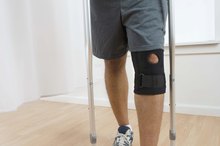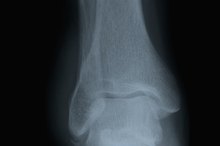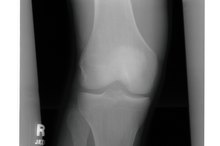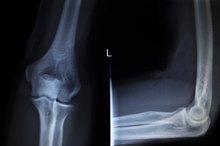Degrees of Ankle Sprain
An ankle sprain occurs when the joint twists or extends beyond its normal limits of flexibility, causing stretching or tearing of the fibrous ligaments that hold the anklebones together. The three degrees of ankle sprains reflect the severity of the ligamentous injury. First, second and third-degree ankle sprains correlate to mild, moderate and severe injuries, respectively. The degree of an ankle sprain affects treatment and expected recovery time.
If you are experiencing serious medical symptoms, seek emergency treatment immediately.
First-Degree Sprain
First-degree ankle sprains reflect slight stretching of the ankle ligaments with a low level of damage to the constituent fibers. The American Academy of Orthopaedic Surgeons notes that mild tenderness may occur 2. Swelling is minimal and bruising proves uncommon with first-degree ankle sprains. Physical examination reveals minimal looseness of the joint. Treatment includes resting the ankle by refraining from participation in sports or recreational activities that would strain the ankle. Application of ice packs and foot elevation can reduce swelling. Recommendations may include use of an elastic wrap for ankle support. Prescribed exercises promoting joint flexibility and strength facilitate return to normal function. According to the University of Iowa Hospitals and Clinics, first-degree ankle sprains heal in approximately four to six weeks.
- First-degree ankle sprains reflect slight stretching of the ankle ligaments with a low level of damage to the constituent fibers.
- Swelling is minimal and bruising proves uncommon with first-degree ankle sprains.
Second-Degree Sprain
Glutamine and Sprained Tendons
Learn More
A second-degree ankle sprain, also known as a grade 2 sprain, represents incomplete tearing of fibers within the ankle ligaments. Symptoms include moderate pain, tenderness and swelling. Bruising commonly appears within a few days of the injury. Physical examination reveals abnormal looseness within the ankle joint. Weight bearing typically proves difficult and painful. The American Academy of Orthopaedic Surgeons states that typical treatment of a second-degree ankle sprain includes short-term immobilization of the joint with an air splint 2. Medications such as acetaminophen, ibuprofen or aspirin provide pain relief. Rest, application of ice packs and foot elevation help reduce swelling. A prescribed course of physical therapy promotes restoration of function. Typical recovery time for a second-degree ankle sprain is one to two months, notes the University of Iowa Hospitals and Clinics.
- A second-degree ankle sprain, also known as a grade 2 sprain, represents incomplete tearing of fibers within the ankle ligaments.
- The American Academy of Orthopaedic Surgeons states that typical treatment of a second-degree ankle sprain includes short-term immobilization of the joint with an air splint 2.
Third-Degree Sprain
A complete tear of one or more of the ankle ligaments characterizes a third-degree, or grade 3, ankle sprain. The joint demonstrates significant instability with marked swelling, tenderness, pain and bruising. Weight bearing typically provokes severe pain. Treatment includes ankle immobilization with a cast or bracing device. An extended physical therapy and rehabilitation program over a period of months facilitates restoration of ankle function. Cedars-Sinai Medical Center notes that third-degree ankle sprains may result in permanent, residual instability of the joint, increasing the risk for repeat ankle injuries. Severe ankle sprains that fail to respond to immobilization and physical therapy may require surgical reconstruction of the torn ligament.
- A complete tear of one or more of the ankle ligaments characterizes a third-degree, or grade 3, ankle sprain.
- Cedars-Sinai Medical Center notes that third-degree ankle sprains may result in permanent, residual instability of the joint, increasing the risk for repeat ankle injuries.
Related Articles
References
Writer Bio
Dr. St. John is a medical writer and editor with more than 15 years experience in the field. She is a former medical officer for the Centers for Disease Control and Prevention.









